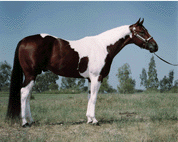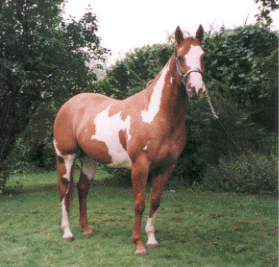


Imagine yourself back in the Old West, when wild horses ran free. Imagine the time when Native American horsemen followed the vast herds of buffalo across the Great Plains. When cowboys traveled hundreds of miles on cattle drives. A time when the horse was vital to survival in the great adventure that was the American West. Among the most treasured of these horses was the one decorated by nature with loud splashes of color-the American Paint Horse.
Descending from the horses introduced by the Spanish conquistadors, these Paints were once wild horses that roamed the Western deserts and plains. Cherished for their unique and appealing patterns, the Paint Horse was loved by cowboys and American Indians alike. The versatile, colorful animals were popular because of their abiltiy and heart, and the finest horsemen of our time recognized the value of Paints.
When they couldn't find a Paint Horse, American Indians painted their plain horses with speical symbols in an attempt to recreate the Paint's magical beauty. One Cheyenne ledgend ties the golden eagle to the black and white horses and explains the special bond Native Americans feel for them. The Sioux have a song that has been handed down from generation to generation about the Paint Horse who returned from the battle of the Little Bighorn. The Pawnee and Arikara tribes have also honored in a war-dance song a spotted horse who returned from battle.
While over the years the conformation and atheltic abiltiy of those rugged mounts of the Old West have been improved by breeders, the unusual and unique coat patterns and coloring have been handed down to their modern descendants. The stock-type conformation, intelligence, and willing attitude make the American Paint Horse an ideal choice for pleasure riding, ranch work, rodeoing, trail riding, racing, showing, and as a friendly mount for the kids.

The American Paint Horse shares a common ancestry with the American Quarter Horse and the American Thoroughbred. The American Paint Horse Association came about as an effort of like-minded horsemen and women who loved the ability and speed of the Western "stock" type horse, but who also appreciated the extra eye appeal of the American Paint.
When the American quarter Horse Association (AQHA) emerged in 1940 to preserve stock horse pedigrees, it adopted standards that excluded horses with painted coat patterns. Regardless of the AQHA registry's color requirements, many American Paints, then and today, are the result of matings between two AQHA-registered parents.
In response to the AQHA restriction on horses with "excessive white" markings, two groups formed to preserve the Paint Horse's rightful heritage: The American Paint Quarter Horse Association, founded in 1961, and the American Paint Stock Horse Association, founded in 1962 by Rebecca Tyler Lockhart. In 1965 the two organizations united to become the American Paint Horse Association (APHA).
Not satisfied to be only a color breed based entirely on coat patterns, the founders of APHA also set a strict standards of conformation, athletic ability and performace, as well as demanding intelligence, a calm temperament and a willing disposition. As proof of their commitment to these ideals, the founders instituted a stringent stallion inspection program that remained in effect until the breed was well established.
To be eligible for registry with the APHA, horses had to come from stock registered with one of four recognized organizations: the American Paint Quarter Horse Associations, the American Paint Stock Horse Association, the Jockey Club (US Thoroughbred Registry), or the American Quarter Horse Association. Today, the three recognized organizations are the APHA, the AQHA, and the Jockey Club. Even though solid-colored horses with Paint Horse bloodlines are included in the APHA registry as Breeding Stock, the association maintains color requirements for registration in the Regular Registry.
The colorful coat pattern is essential to the identity of the breed, and preserving these unique coat patterns is the purpose for which the association was formed.

A registered American Paint Horse is more than a horse with a distinctive coat pattern. While color is the most obvious trait, American Paint Horses also possess a distinct stock-type conformation.
In horseman's lingo, this refers to the physical confomration and characteristics that make a horse especially well-suited to working with livestock. These same traits also make them extraordinarily versatile, and capable of activities requiring tremendous speed, strength and agility.
When looking at a "stock horse" such as the Paint, you will notice that it is well muscled and powerfully built. American Paint Horses are generally short-coupled, strong-boned, and well-balanced. yet Paints display a remarkable degree of refinement and beauty, especially about the head and neck. While there is some individual variation in the size and substance of today's American Paint Horses, it is clear that each individual is cast from the same quality mold.

The overo (ohvair' oh) pattern may be either predominately dark or white. But, typically, the white on an overo will not cross the back of the horse between its withers and its tail. Generally, all four legs will be dark. Also notable is that overos have bold white head markings, such as a bald face. Overos generally have irregular, scattered markings. The horse's tail is usually one color.
Here is an example of an overo pattern

The tobiano (toe-be-yah' no) is distinguished by head markings like those of a solid color horse. Their heads are generally completely solid. A tobiano's legs are white, at least below the hocks and knees. Their spots are regular and distinctively oval or round, extending down the neck and chest, giving the appearance of a shield. Usually a tobiano will have the dark color on one or both flanks–although they may be either predominately dark or white. The tail is often two colors.
Here is an example of an tobiano pattern.

The tovero (toh vair' oh) pattern combines the characteristics of both tobianos and overos.
Here is an example of a tovero pattern.
